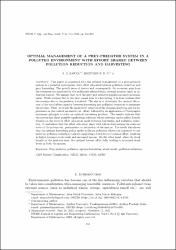| dc.contributor.author | Zawka, Simon Derkee | en_US |
| dc.contributor.author | Srinivasu, Pichika D.N. | en_US |
| dc.date.accessioned | 2024-04-05T16:25:50Z | |
| dc.date.available | 2024-04-05T16:25:50Z | |
| dc.date.issued | 2024-04 | |
| dc.identifier.citation | Zawka, Simon D. & Srinivasu, P. D.N. (2024). Optimal management of a prey-predator system in a polluted environment with effort shared between pollution reduction and harvesting. TWMS Journal Of Applied And Engineering Mathematics, 14(2), 816-833. | en_US |
| dc.identifier.issn | 2146-1147 | en_US |
| dc.identifier.issn | 2587-1013 | en_US |
| dc.identifier.uri | https://hdl.handle.net/11729/5970 | |
| dc.identifier.uri | https://jaem.isikun.edu.tr/web/index.php/current/124-vol14no2/1216 | |
| dc.description.abstract | This paper is concerned with the optimal management of a prey-predator system in a polluted environment with effort allocated between pollution reduction and prey harvesting. The growth rates of species and, consequently, the economic gain from the resources are impacted by the pollutants released from external sources (such as industrial wastes). We assume that both the prey and predator populations have economic value. While revenue due to the prey comes from it’s harvesting, it is from tourism that the revenue due to the predator is realised. The aim is to determine the optimal allocation of the total effort capacity between harvesting and pollution reduction to maximize the revenue. First, we study the qualitative behavior of the dynamical system and its dependence on the control parameter viz., effort, followed by an application of Pontryagin’s maximum principle to solve an optimal harvesting problem. The results indicate that the system has three possible equilibrium solutions whose existence and stability heavily depend on the level of effort allocation made between harvesting and pollution reduction. It underlines that the effort allocation plays vital role in determining the eventual state of the system viz., permanence or extinction of the species. The result also shows that the optimal harvesting policy under pollution reduction efforts (as compared to one under no pollution reduction) calls for employing a lower level of optimal effort, resulting in higher resource stock levels and increased income. On the other hand, when the stock benefit of the predator rises, the optimal harvest effort falls, leading to increased stock levels in both the species. | en_US |
| dc.language.iso | en | en_US |
| dc.publisher | Işık University Press | en_US |
| dc.relation.ispartof | TWMS Journal Of Applied And Engineering Mathematics | en_US |
| dc.rights | info:eu-repo/semantics/openAccess | en_US |
| dc.rights | Attribution-NonCommercial-NoDerivs 3.0 United States | * |
| dc.rights.uri | http://creativecommons.org/licenses/by-nc-nd/3.0/us/ | * |
| dc.subject | Prey-predator | en_US |
| dc.subject | Pollution | en_US |
| dc.subject | Optimal harvesting | en_US |
| dc.subject | Stock benefit | en_US |
| dc.subject | Pollution-reduction | en_US |
| dc.title | Optimal management of a prey-predator system in a polluted environment with effort shared between pollution reduction and harvesting | en_US |
| dc.type | Article | en_US |
| dc.description.version | Publisher's Version | en_US |
| dc.identifier.volume | 14 | |
| dc.identifier.issue | 2 | |
| dc.identifier.startpage | 816 | |
| dc.identifier.endpage | 833 | |
| dc.peerreviewed | Yes | en_US |
| dc.publicationstatus | Published | en_US |
| dc.relation.publicationcategory | Makale - Uluslararası Hakemli Dergi - Başka Kurum Yazarı | en_US |
| dc.indekslendigikaynak | Scopus | en_US |
| dc.indekslendigikaynak | Emerging Sources Citation Index (ESCI) | en_US |




















